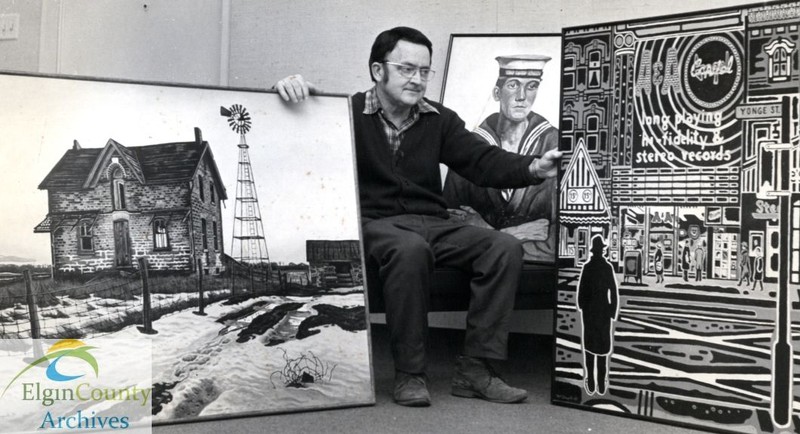Clark McDougall Mural: "Talbot Street"
Introduction
Text-to-speech Audio
Images
A reproduction of Clark McDougall's "Ann's Snack Bar" (1964) on the side of the 230 Talbot St.

Clark McDougall sketching in Elgin County ca. 1972-1980.

Clark McDougall and two of his paintings at a show in the Art Gallery of St. Thomas and Elgin in 1972.

Backstory and Context
Text-to-speech Audio
Clark McDougall was born in St. Thomas in 1921[1]. By the time he left school at age 16, he was determined to be an artist and had already started to develop a distinctive style. He would ride his bike north of his home in St. Thomas into the North Yarmouth countryside to paint all day[2]. There he built relationships with local farmers as he captured the unique southwestern Ontario landscape[3]. He later also turned to depicting city streetscapes, often in his hometown of St. Thomas.
“I love the beautiful silence of landscape with infinity on the east horizon especially, where I can look for miles and dream of a heaven like this, designed just for painters where time is frozen until you complete your painting.”
Clark McDougall started working in watercolours, but continued experimenting with different mediums throughout his life.[4] He learned to use oil paints so that he could continue painting outdoors during the wintertime without having to worry about the paint freezing.[5] He also created works with acrylics, charcoal, ink, pencil, and felt-tip markers.[6]
“I think that when a person is painting full-time in order to offset boredom he has to keep using different methods to try to keep the process…I’d have to call it a renewal. That’s what it amounts to, you have to keep getting recharged all the time.”
Although he lived in St. Thomas his entire life, he took a trip to Montreal and Quebec City in 1950 where he discovered Matisse and other fauvist painters.[7] The fauvist influence can be seen in his paintings after this date, with their vivid colours and a more simplistic, abstract approach than that seen in his previous work. It was during this period that Clark painted his iconic Talbot Street which depicts a view down Talbot Street with vivid blue puddles in the streets and highlights of bright orange and yellow.[8]
Talbot Street is among the first works to employ heavy Black enamel outlines filled in with coloured oil paints, the style for which he is best known. It was a style that allowed him to play with form and colour in a more abstract way than before, while still depicting the barns, landscapes, and streets of his home. He was particularly interested in the contrast between the glossy finish of the enamel and the matte finish of the coloured oil paint.[9]
Many of the stores depicted in the painting can be identified by their prominent, mainly neon, signs. Ann’s Snack Bar, Tip-Top Tailors, F.W. Woolworth’s, Young’s Jewelers, Maher Shoes, Standard Drugs, and in the distance the Diana Grill, Dowler’s and Gettas’ Restaurant. Ann’s Snack Bar was demolished not long after this painting was created, following the fate of Charlie Wong’s Laundry next door, which had been demolished in 1959 after over 50 years of operation and later became the site of Hepburn Park.[10] [11]
The “Green Spot Ladies”—Bert McKay and Margaret Thorman—who were behind the installation of the Rebecca Sisler sculpture in Hepburn Park, were also key figures, along with Lois Farley, in the founding of the St. Thomas and Elgin Art Gallery, now the St. Thomas Elgin Public Art Centre (STEPAC).[12] They started building a permanent collection with the proceeds of what would become an annual art auction beginning in 1969. Talbot Street was the first work to be purchased from that year’s proceeds.[13] The painting has since become well-known through reproductions by STEPAC.
Throughout his career as an artist, Clark McDougall often looked to music as inspiration. His Black enamel paintings were inspired by 12 tone atonal music, a modern music composition technique that uses all 12 tones of the chromatic musical scale in equal numbers.[14] [15]
“Music is one of my main interests. Well it is my main interest. I’m more interested in classical music than I am in any other form of music. Actually it’s through music I think that I’ve been able to understand the process of my own changes in painting which have come about since 1950.”
Clark McDougall died in 1980 at age 59, leaving behind a legacy of paintings and sketches that capture the beauty and intimacies of his home.[16] Today, in addition to private collections, large collections of work exist at STEPAC, as well as the McIntosh Gallery at Western University and Museum London.[17] [18] [19]
[2] Ibid.
[3] Exhibit Guide (Catherine Elliot Shaw), p. 7
[4] Clark McDougall in “The Relentless Pursuit” video, 8:20-11:23
[5] Ibid, 5:05-8:20
[6] Exhibit Guide (Catherine Elliot Shaw), p. 13
[7] Clark McDougall in “The Relentless Pursuit” video, 18:10-22:07
[8] Railway City Tourism Announcement
[9] Ibid, 39:30-45:00
[10] Ibid, pp. 277-8
[11] St. Thomas Times Journal, 1964, Elgin County Archives
[12] STEPAC history, stepac.ca
[13] St. Thomas Times Journal, 1969, Elgin County Archives
[14] Ibid, 23:30-27:24
[15] Open Music Theory, “Twelve Tone Basics”
[16] STEPAC Artist Profiles
[17] stepac.ca
Sources
St. Thomas Elgin Public Art Centre. (n.d.) "Clark McDougall" in Artist Profiles. Retrieved from http://stepac.ca/artist-profiles
Shaw, C.E. (2010). Clark McDougall: A Life on the Land [Exhibit guide].
St. Thomas Elgin Public Art Centre. (2017). Clark McDougall - "the relentless pursuit" [Video]. YouTube. https://www.youtube.com/watch?v=vW1kJhXQPQs
Railway City Tourism. (2015). Rare glimpse into Clark McDougall's work. Retrieved from https://www.railwaycitytourism.com/blog/rare-glimpse-into-clark-mcdougalls-work
